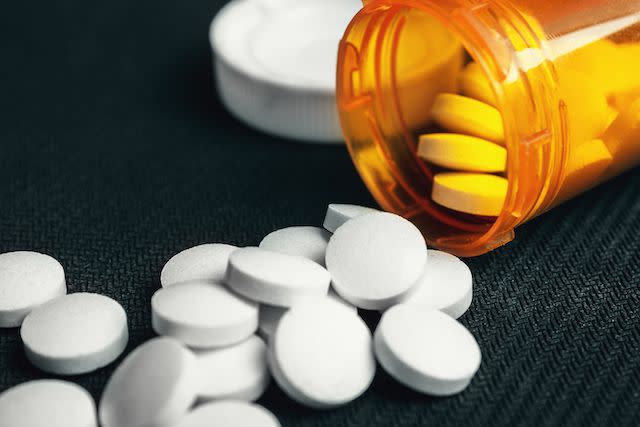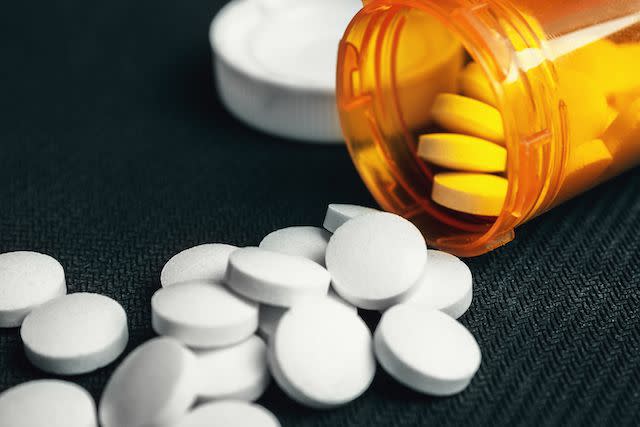Comparing Concerta vs. Adderall

When looking to manage symptoms associated with attention deficit hyperactivity syndrome (ADHD) or narcolepsy, finding a prescription medication that works effectively for yourself or a loved one is critical in adequately managing either of these conditions.
As such, your healthcare provider may prescribe one of these Food and Drug Administration (FDA)-approved, brand-name medications: Concerta (methylphenidate) or Adderall (amphetamine/dextroamphetamine).
Concerta and Adderall, classified as central nervous system (CNS) stimulants, can help alleviate the symptoms of ADHD and narcolepsy. Both drugs also share the exact mechanism of action (the medical term for how a drug works).
However, Concerta and Adderall possess some critical differences regarding their dosing amounts, age requirements, and active ingredients, amongst other differences.
This article will compare Concerta and Adderall, examining their specific indications, dosing regimens, safety concerns, potential for drug-related interactions, and more.

Overview of Concerta and Adderall
CNS stimulants are a commonly used type of medication for the management of ADHD and narcolepsy medication.
CNS stimulants work by increasing levels of chemicals (dopamine and norepinephrine) in the brain.
Concerta is an orally administered (taken by mouth) medicine that contains the active ingredient methylphenidate.
Concerta, approved for use in adults and children 6 and older, is available as an extended-release (ER, a form of administration where the drug's effects happen slowly inside the body) tablet.
In comparison, Adderall, also orally administered, is a combination of two drugs, amphetamine, and dextroamphetamine.
Adderall is available in immediate-release (IR, a form of administration where the drug instantly disintegrates, quickening its impact) and ER dosage forms.
Concerta and Adderall are classified by the Drug Enforcement Administration (DEA) as Schedule II Controlled Substances because they have a high potential for abuse and dependence.
When to Use Concerta vs Adderall
Concerta and Adderall are prescribed as part of a treatment program to control symptoms of ADHD. People can also use these drugs to treat narcolepsy.
These drugs improve symptoms such as difficulty focusing, controlling actions, and remaining still or quiet as other people of the same age.
Treatment of ADHD
People with ADHD may experience various symptoms, including inattention to detail, hyperactivity, personal conduct disorders, or poor organizational skills.
Per the Centers for Disease Control and Prevention (CDC), children 6 and older who are diagnosed with ADHD should undergo medication and behavioral therapy.
Conversely, the CDC recommends that only behavioral treatment be used for children under 6 years old with ADHD, as they state that behavioral therapy is just as effective as medication for young children.
For older adults, the management of ADHD may also include mental health counseling and a prescription drug regime. These efforts can improve their ability to socialize or perform effectively in the workplace.
However, most people who take ADHD-related drugs are children and adolescents.
Treatment of Narcolepsy
Narcolepsy is most likely to first appear in young adults in their late and early 20s. And similar to ADHD, narcolepsy is also treatable but not curable.
Notably, there are two types of narcolepsy, type 1 and type 2.
The presence of cataplexy (the sudden loss of muscle tone) marks type 1 narcolepsy. In comparison, type 2 narcolepsy is narcolepsy without cataplexy. Those with type 2 have healthy levels of hypocretin (a type of neurotransmitter).
Treatments usually begin with medications, but daily routine and lifestyle changes can also help.
Once lifestyle changes are deemed ineffective, a healthcare provider may begin prescribing certain medications for its management, including antidepressants (e.g., Effexor XR [venlafaxine]) or amphetamine-like stimulants, like Concerta.
Side Effects and Safety
In addition to being labeled as controlled substances, each drug carries a boxed warning that each has the potential for severe adverse effects.
Concerta and Adderall are generally safe drugs when taken according to the prescribed dose. However, both share common and more severe side effects.
The efficacy and prevalence of side effects tend to be individualized to the individual, which is why many different forms of these stimulants exist.
Common Side Effects
Common side effects associated with the consumption of Concerta and Adderall include:
Dizziness
Nausea and vomiting
Loss of appetite
Stomach pain
Diarrhea
Dry mouth
Headache
Drowsiness
Dystonia (uncontrollable movement of a body part)
Restlessness
Decreased libido (sexual desire)
Severe Side Effects
More severe side effects associated with the consumption of Concerta and Adderall include:
Aggravating or instigating psychiatric issues, such as psychosis and bipolar disorder
Heart (cardiovascular) issues, such as hypertension (high blood pressure)
Growth suppression in children (if used long-term)
Increased aggression
Peripheral artery disease (PAD, when one or more of the arteries supplying blood to the legs, arms, head, or abdomen become obstructed)
Motor or verbal tics
Hoarseness
Difficulty breathing or swelling
Concerta may have additional side effects, including priapism (a prolonged, painful erection) that lasts for hours and gastrointestinal (GI) obstruction.
Who Shouldn't Take Concerta or Adderall?
Concerta and Adderall are both contraindicated (a preexisting condition for which a drug should not be used) in the following:
Known hypersensitivity to respective ingredients within Concerta or Adderall
A form of glaucoma (a group of eye diseases that cause damage to the optic nerve)
Monoamine oxidase inhibitors (MAOIs, a type of antidepressant medication) taken within or following two weeks (14 days) of Concerta or Adderall usage
Some additional contraindications to Adderall are:
Advanced arteriosclerosis (vascular diseases that involve the thickening and loss of elasticity of the arteries' walls)
Symptomatic cardiovascular disease
Moderate to severe hypertension
Hyperthyroidism (a condition that arises as a result of an overactive thyroid gland)
Tell your healthcare provider if you are pregnant before taking these drugs. Do not breastfeed while you are taking Concerta or Adderall.
Similarly, Concerta is contraindicated in the diagnosis of or a preexisting family history of tics and Tourette's syndrome.
How to Take Concerta vs Adderall
While both drugs are taken orally, they have different dosing regimens and strengths associated with a specific prescription.
It should be noted that Concerta is an ER tablet that can not be broken or split. This can be difficult for people like children who can not swallow pills.
On the other hand, Adderall XR capsules can be opened and sprinkled into drinks, apple sauce, or pudding.
Additionally, due to the different peak times of the medications, some people may have more difficulty sleeping with one drug than another.
Taking Concerta
Concerta is available as ER tablets with 18-milligram (mg), 27-milligram, 36-milligram, and 54-milligram dosage strength.
Take Concerta once daily in the morning, with or without food. Do not chew, crush, or break the tablets. Swallow it whole with water.
Concerta reaches peak levels inside the bloodstream within five to nine hours.
The recommended starting dose of Concerta for people currently not taking any methylphenidate drug or any other stimulant-type medication:
For children and adolescents, 18 milligrams once daily
For adults, 18 milligrams or 36 milligrams once daily
Concerta's recommended starting dosing and ranging regime:
For children 6 to 12, the recommended dose is 18 milligrams/day, with a maximum limit of 18 to 54 milligrams/day.
For adolescents 13 to 17, the recommended dose is 18 milligrams/day, with a maximum limit of 18 to 72 milligrams/day.
The recommended dose for adults 18 to 65 is 18 milligrams/day, with a maximum limit of 18 to 72 milligrams/day.
The recommended dose of Concerta for those currently taking methylphenidate twice or three times a day at doses of 10 to 60 milligrams/day are:
For those taking a previous dose of 5 milligrams of methylphenidate twice or thrice daily, the recommended dose is 18 milligrams daily.
For those taking a previous dose of 10 milligrams of methylphenidate twice or thrice a day, the recommended dose is 36 milligrams daily.
For those taking a previous dose of 15 milligrams of methylphenidate twice or thrice a day, the recommended dose is 54 milligrams daily.
For those taking a previous dose of 20 milligrams of methylphenidate twice or thrice a day, the recommended dose is 72 milligrams daily.
Narcolepsy dosing:
The usual dose of Concerta is 5 to 60 milligrams daily in divided doses, depending on the individual need and response. The suggested initial amount for children 6 to 12 is 5 milligrams daily.
However, narcolepsy seldom occurs in children under 12 years of age.
Taking Adderall
Adderall IR is available in 5-milligram (mg), 10-milligram, 12.5-milligram, 15-milligram, 20-milligram, and 30-milligram tablets.
Standard ADHD dosing:
In children ages 3 to 5, start with 2.5 milligrams daily. The amount may be raised if determined by your healthcare provider.
In children 6 and older, the standard starting dose is 5 milligrams once or twice daily. The amount may be raised if determined by your healthcare provider.
Adderall XR is available in dosage strengths of 5-milligram, 10-milligram, 15-milligram, 20-milligram, 25-milligram, and 30-milligram capsules.
Take an Adderall XR capsule, or sprinkle the entire contents on applesauce. Consume sprinkled applesauce immediately, and do not store it. Take the entire contents of the capsule and take at most one tablet per day with or without food.
Take Adderall XR upon awakening. Avoid afternoon doses because of the potential for insomnia.
Where possible, interrupt Adderall XR therapy occasionally to determine if the recurrence of behavioral symptoms is sufficient to require continued treatment:
In children 6 to 12 with ADHD, the standard dose is 10 milligrams once daily in the morning. However, the amount may be raised if determined by your healthcare provider.
The recommended starting dose for adolescents (13 to 17) with ADHD is 10 milligrams/day. However, the amount may be raised if determined by your healthcare provider.
In adults 18 and older with ADHD, the recommended dose is 20 milligrams/day.
Notably, the maximum systemic absorption of Adderall XR is seven hours compared to three hours for IR tablets.
Storage
Storage recommendations for Concerta and Adderall are at a controlled temperature of 59 to 86 F. Store away from heat, direct light, and areas susceptible to high moisture levels (e.g., the bathroom).
Keep all the medicines locked out of sight and reach of children and pets. Discard the unwanted medication properly. Ask your local pharmacist for information.
Concerta vs Adderall Interactions
Concerta and Adderall interact with some drugs that include:
MAO inhibitors, such as:
Marplan (isocarboxazid)
Zyvox (linezolid)
Provay Blue (methylene blue)
Nardil (phenelzine)
Azilect (rasagiline)
Zelapar (selegiline)
Parnate (tranylcypromine)
Anticoagulants (blood thinners), such as:
Jantoven (warfarin)
Antidepressants, such as:
Anafranil (clomipramine)
Norpramin (desipramine)
Tofranil (imipramine)
Medicines for seizures, such as:
Sezaby (phenobarbital)
Dilantin (phenytoin)
Mysoline (primidone)
Selective serotonin reuptake inhibitors (SSRIs) such as:
Celexa (citalopram)
Lexapro (escitalopram)
Prozac (fluoxetine)
Luvox (fluvoxamine)
Brisdelle (paroxetine)
Zoloft (sertraline)
Tell your healthcare provider about all the drugs you take before taking any of these medicines. Your healthcare provider may need to change the drug dose to avoid interactions.
Summary
Living with or helping a loved one manage symptoms of ADHD or narcolepsy can be challenging. Fortunately, prescription medication has proven effective in treating ADHD and narcolepsy.
If in this position, you or a loved one may be prescribed Concerta or Adderall—two drugs that are more similar than they are different.
More specifically, while both possess the exact mechanism of action, their respective age, dosing regimens, and preexisting health requirements for use differ slightly.
These drugs must be used only when prescribed. Any recreational use or misuse may lead to addiction and dependence on the drug.
Therefore, your healthcare provider will best decide the choice of drug regarding your health condition and therapeutic requirements.
Frequently Asked Questions
Generally, how many children with ADHD reach adulthood with ADHD?
ADHD symptoms may vary with growing age and become less severe in adulthood. But in some cases, they do not necessarily go away.
Children with ADHD in childhood are often still affected by the condition in the majority. According to one study, 29% of those diagnosed in childhood had ADHD symptoms as adults.

